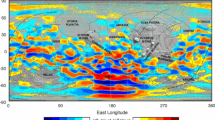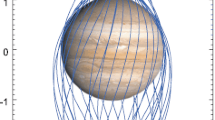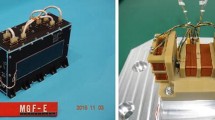Abstract
The Galileo Orbiter carries a complement of fields and particles instruments designed to provide data needed to shed light on the structure and dynamical variations of the Jovian magnetosphere. Many questions remain regarding the temporal and spatial properties of the magnetospheric magnetic field, how the magnetic field maintains corotation of the embedded plasma and the circumstances under which corotation breaks down, the nature of magnetic perturbations that transport plasma across magnetic shells in different parts of the system, and the electromagnetic properties of the Jovian moons and how they interact with the magnetospheric plasma. Critical to answering these closely related questions are measurements of the dc and low-frequency magnetic field. The Galileo Orbiter carries a fluxgate magnetometer designed to provide the sensitive measurements required for this purpose. In this paper, the magnetometer is described. The instrument has two boom-mounted, three-axis sensor assemblies. Flipper mechanisms are included in each sensor assembly for the purpose of offset calibration. The microprocessor controlled data handling system produces calibrated despun data that can be used directly without further processing. A memory system stores data for those periods when the spacecraft telemetry is not active. This memory system can also be used for storing high time-resolution snapshots of data.
Similar content being viewed by others
References
Acuna, M. H., Behannon, K. W., and Connerney, J. E. P.: 1983, in A. J. Dessler (ed.), Physics of the Jovian Magnetosphere, Cambridge University Press, Cambridge, MA
Belcher, J. W.: 1983, in A. J. Dessler (ed.), Physics of the Jovian Magnetosphere, Cambridge University Press, Cambridge, MA.
Bevington, P. R.: 1969, Data Reduction and Error Analysis for the Physical Sciences, McGraw-Hill Book Co., New York.
Birmingham, T. J.: 1983, Rev. Geophys. 21, 375.
Connerney, J. E. P.: 1987, Rev. Geophys. 25, 615.
Dessler, A. J. (ed.): 1983, Physics of the Jovian Magnetosphere, Cambridge University Press, Cambridge, MA.
Gehrels, T., (ed.): 1976, Jupiter, University Arizona Press, Tucson.
Gordon, D. I. and Brown, R. E.: 1972, IEEE Transactions on Magnetics MAG-8, 76.
Hill, T. W.: 1979, J. Geophys. Res. 84, 6554.
Kanasewich, E. R.: 1975, Time Series Analysis in Geophysics, University Alberta Press, Edmonton, Canada.
Khurana, K. K., Chen, S.-H., Hammond, C. M., and Kivelson, M. G.: 1991, Adv. Space Res., (in press).
Kivelson, M. G., Slavin, J. A., and Southwood, D. J.: 1979, Science 205, 491.
Krimigis, S. M. and Roelof, E. C.: 1983, in A. J. Dessler (ed.), Physics of the Jovian Magnetosphere, Cambridge University Press, Cambridge, MA.
Ness, N. F., Behannon, K. W., Lepping, R. P., and Schatten, K. H.: 1971, J. Geophys. Res. 76, 3564.
Russell, C. T.: 1978, IEEE Transactions on Geoscience Electronics GE-16 (3).
Snare, R. C. and Means, J. D.: 1977, IEEE Transactions on Magnetics MAG-13 (5).
Vasyliunas, V. M.: 1983, in A. J. Dessler (ed.), Physics of the Jovian Magnetosphere, Cambridge University Press, Cambridge, MA.
Author information
Authors and Affiliations
Rights and permissions
About this article
Cite this article
Kivelson, M.G., Khurana, K.K., Means, J.D. et al. The Galileo magnetic field investigation. Space Sci Rev 60, 357–383 (1992). https://doi.org/10.1007/BF00216862
Issue Date:
DOI: https://doi.org/10.1007/BF00216862




